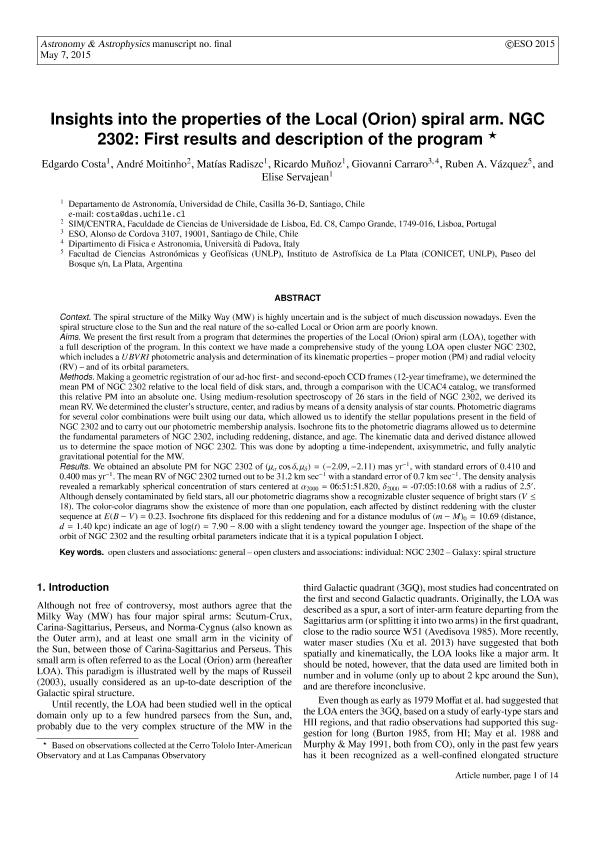Mostrar el registro sencillo del ítem
dc.contributor.author
Costa, Edgardo
dc.contributor.author
Moitinho, André
dc.contributor.author
Radiszc, Matías
dc.contributor.author
Muñoz, Ricardo
dc.contributor.author
Carraro, Giovanni
dc.contributor.author
Vazquez, Ruben Angel

dc.contributor.author
Servajean, Elise
dc.date.available
2017-03-17T19:40:38Z
dc.date.issued
2015-06
dc.identifier.citation
Costa, Edgardo ; Moitinho, André ; Radiszc, Matías ; Muñoz, Ricardo ; Carraro, Giovanni ; et al.; Insights into the properties of the Local (Orion) spiral arm. NGC 2302: first results and description of the program; Edp Sciences; Astronomy And Astrophysics; 580; 6-2015; 1-14
dc.identifier.issn
0004-6361
dc.identifier.uri
http://hdl.handle.net/11336/14053
dc.description.abstract
Context. The spiral structure of the Milky Way (MW) is highly uncertain and is the subject of much discussion nowadays. Even the spiral structure close to the Sun and the real nature of the so-called Local or Orion arm are poorly known.
Aims. We present the first result from a program that determines the properties of the Local (Orion) spiral arm (LOA), together with a full description of the program. In this context we have made a comprehensive study of the young LOA open cluster NGC 2302, which includes a UBVRI photometric analysis and determination of its kinematic properties – proper motion (PM) and radial velocity (RV) – and of its orbital parameters.
Methods. Making a geometric registration of our ad-hoc first- and second-epoch CCD frames (12-year timeframe), we determined the mean PM of NGC 2302 relative to the local field of disk stars, and, through a comparison with the UCAC4 catalog, we transformed this relative PM into an absolute one. Using medium-resolution spectroscopy of 26 stars in the field of NGC 2302, we derived its mean RV. We determined the cluster’s structure, center, and radius by means of a density analysis of star counts. Photometric diagrams for several color combinations were built using our data, which allowed us to identify the stellar populations present in the field of NGC 2302 and to carry out our photometric membership analysis. Isochrone fits to the photometric diagrams allowed us to determine the fundamental parameters of NGC 2302, including reddening, distance, and age. The kinematic data and derived distance allowed us to determine the space motion of NGC 2302. This was done by adopting a time-independent, axisymmetric, and fully analytic gravitational potential for the MW.
Results. We obtained an absolute PM for NGC 2302 of (μαcosδ,μδ) = (−2.09,−2.11) mas yr-1, with standard errors of 0.410 and 0.400 mas yr-1. The mean RV of NGC 2302 turned out to be 31.2 km s-1 with a standard error of 0.7 km s-1. The density analysis revealed a remarkably spherical concentration of stars centered at α2000 = 06:51:51.820, δ2000 = −07:05:10.68 with a radius of 2.5′. Although densely contaminated by field stars, all our photometric diagrams show a recognizable cluster sequence of bright stars (V ≤ 18). The color–color diagrams show the existence of more than one population, each affected by distinct reddening with the cluster sequence at E(B−V) = 0.23. Isochrone fits displaced for this reddening and for a distance modulus of (m−M)0 = 10.69 (distance, d = 1.40 kpc) indicate an age of log (t) = 7.90–8.00 with a slight tendency toward the younger age. Inspection of the shape of the orbit of NGC 2302 and the resulting orbital parameters indicate that it is a typical population I object.
dc.format
application/pdf
dc.language.iso
eng
dc.publisher
Edp Sciences

dc.rights
info:eu-repo/semantics/openAccess
dc.rights.uri
https://creativecommons.org/licenses/by-nc-sa/2.5/ar/
dc.subject
Open Clusters
dc.subject
Ngc 2302 (Galaxia)
dc.subject
Galaxy
dc.subject
Associations
dc.subject
Spiral Structure
dc.subject.classification
Astronomía

dc.subject.classification
Ciencias Físicas

dc.subject.classification
CIENCIAS NATURALES Y EXACTAS

dc.title
Insights into the properties of the Local (Orion) spiral arm. NGC 2302: first results and description of the program
dc.type
info:eu-repo/semantics/article
dc.type
info:ar-repo/semantics/artículo
dc.type
info:eu-repo/semantics/publishedVersion
dc.date.updated
2017-03-06T18:08:35Z
dc.journal.volume
580
dc.journal.pagination
1-14
dc.journal.pais
Francia

dc.journal.ciudad
Paris
dc.description.fil
Fil: Costa, Edgardo . Universidad de Chile; Chile
dc.description.fil
Fil: Moitinho, André . Universidade de Lisboa; Portugal
dc.description.fil
Fil: Radiszc, Matías . Universidad de Chile; Chile
dc.description.fil
Fil: Muñoz, Ricardo . Universidad de Chile; Chile
dc.description.fil
Fil: Carraro, Giovanni . European Southern Observatory; Chile. Universita Di Padova; Italia
dc.description.fil
Fil: Vazquez, Ruben Angel. Consejo Nacional de Investigaciones Científicas y Técnicas. Centro Científico Tecnológico La Plata. Instituto de Astrofísica de La Plata; Argentina
dc.description.fil
Fil: Servajean, Elise . Universidad de Chile; Chile
dc.journal.title
Astronomy And Astrophysics

dc.relation.alternativeid
info:eu-repo/semantics/altIdentifier/url/http://www.aanda.org/articles/aa/abs/2015/08/aa25784-15/aa25784-15.html
dc.relation.alternativeid
info:eu-repo/semantics/altIdentifier/doi/https://doi.org/10.1051/0004-6361/201525784
Archivos asociados
